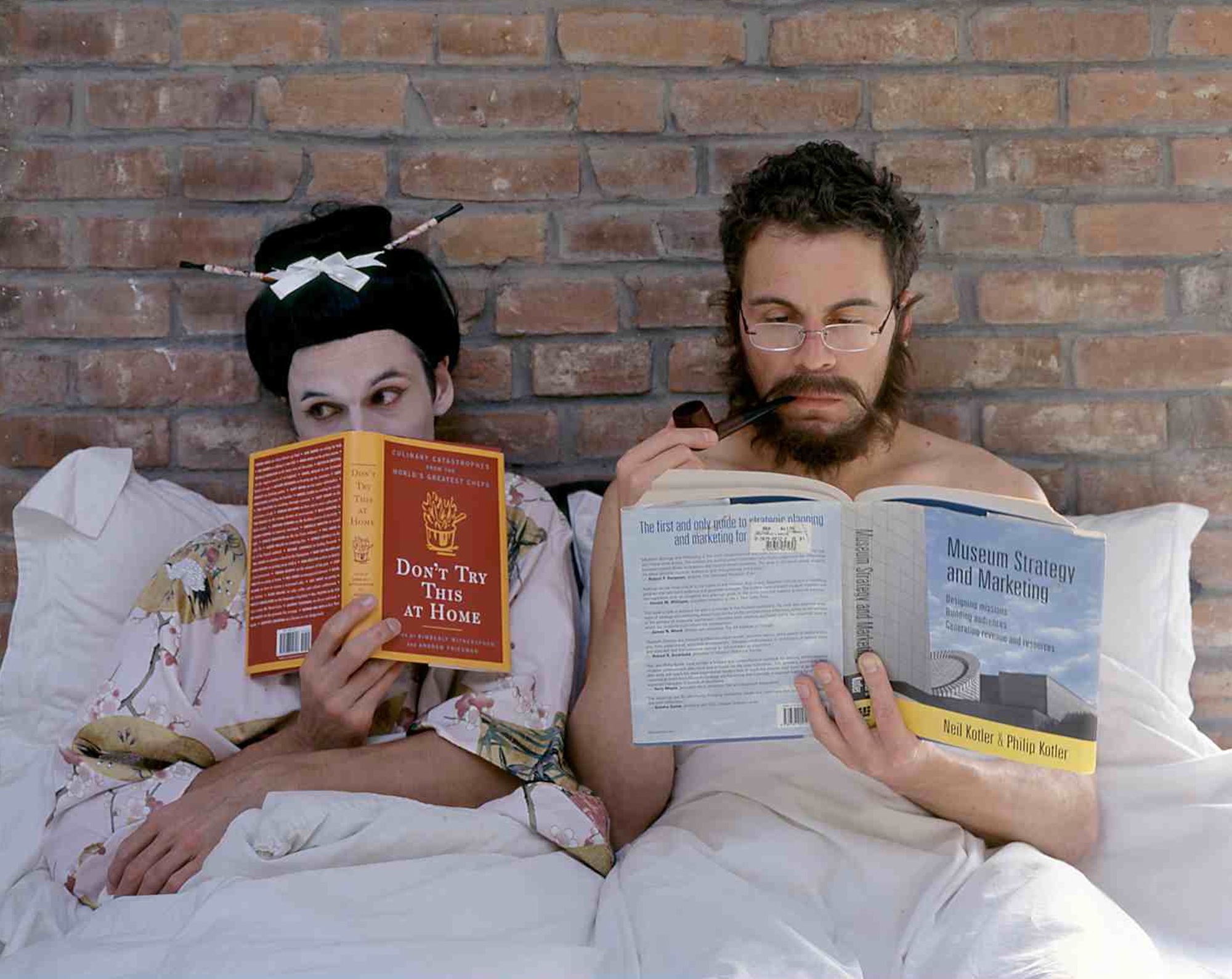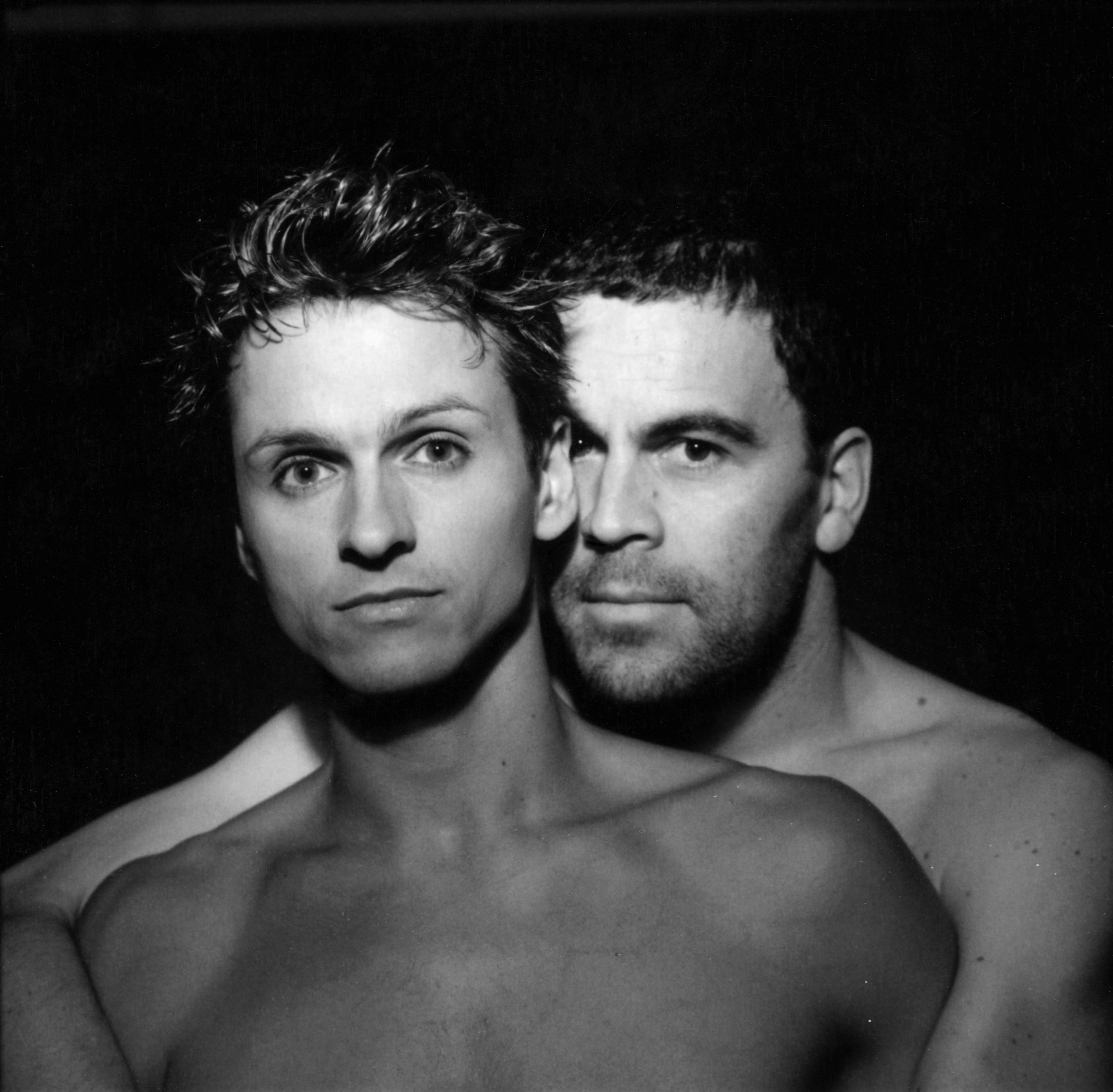
In her "Artist's Life Manifesto," legendary performance artist Marina Abramovic offers this advice:
An artist should avoid falling in love with another artist.
An artist should avoid falling in love with another artist.
An artist should avoid falling in love with another artist.
Her fervent insistence on this principle is no doubt informed by the demise of her decade-long partnership with her collaborator Ulay (Frank Uwe Laysiepen). In their performance Breathing In, Breathing Out, Ulay and Abramovic connected their mouths and inhaled each other's breaths until they ran out of oxygen and collapsed to the floor, unconscious. In The Lovers, they famously turned their break-up into an elaborate, symbolic 90-day performance piece, in which both artists walked over 1200 miles across the Great Wall of China from opposite ends, meeting in the middle to say farewell. Their journey serves as a potent reminder that a relationship can only endure so much passion, ego, self-flagellation and suffering.
Is there some validity to Abramović's advice or is she simply scarred and blinded by her own experience? Should artists seek stability with a more practical-minded type -- someone who can nurture their creative endeavors and chase away their insecurities?
The world has known plenty of celebrated artist duos. Some have produced rich collaborations (Christo and Jeanne-Claude); others blossomed into nurturing mentorships (Alfred Stieglitz and Georgia O'Keeffe), destructive disasters (Courtney Love and Kurt Cobain), fraught rivalries (James Cameron and Kathryn Bigelow), and fascinating Freudian family dramas (Woody Allen and Mia Farrow).
Famous fruitful gay partnerships have included Merce Cunningham and John Cage, Susan Sontag and Annie Leibowitz, and Christopher Isherwood and Don Bachardy. Perhaps the most devoted gay literary couple -- Gertrude Stein and Alice B. Toklas -- took the idea of collaboration to the next level, when, in 1933, Stein wrote an homage to her muse, written from Toklas' point of view. The Autobiography of Alice B. Toklas became Stein's first bestseller.
On the occasion of the 80th anniversary of Stein's masterpiece, New-York based performance artist Filip Noterdaeme decided to revisit the form of the conceptual memoir to tell the tale of his love affair with the German cabaret entertainer Daniel Isengart. Noterdaeme's The Autobiography of Daniel J. Isengart (published this month by Outpost19, with a Foreword by Penny Arcade) is a celebration of two gay artists carving out a most unusual and fulfilling life for themselves in New York City.
I sat down with Isengart, the subject of this intriguing memoir to discuss the pleasures and pitfalls of artist-on-artist romance:
 Daniel Isengart (left) and Filip Noterdaeme. Photo courtesy of Russel Gera.
Daniel Isengart (left) and Filip Noterdaeme. Photo courtesy of Russel Gera.
Why are Gertrude Stein and Alice B. Toklas such appealing figures for you and Filip? When did you first become fascinated with them?
I read Gertrude Stein's The Autobiography of Alice B. Toklas in the early '90s, shortly after moving to New York. I loved the deadpan, unemotional tone of the book, the clipped, purely descriptive and oddly declarative style that nevertheless managed to convey a perfectly symbiotic relationship. Filip actually studied Stein's writings extensively at NYU and wrote his thesis about her in 1995. When he decided to use The Autobiography of Alice B. Toklas as a template to tell our story, I was at first a bit taken aback; it was such an unusual approach. But then, I realized that there were indeed many intriguing parallels: Like us, they were immigrants, openly gay, ran an artistic salon in their home, counted many artists among their friends, had the highest regard for good food, co-conspired artistically and were, although very distinct in appearance and character, inseparable. Of course, their most notable achievement is that it is now impossible to think of one without the other -- theirs is simply one of the greatest documented relationships of the Twentieth Century.
What was your reaction when you first read your own "autobiography"?
I couldn't stop laughing. The book is a hilarious ménage a quatre: Filip telling our story using my voice but filtering it through The Autobiography of Alice B. Toklas, in which Stein had appropriated Alice's highly particular, clipped syntax. It's unlike anything I have ever read.
What do you make of Abramovic's advice to avoid falling in love with another artist? I know you are both quite critical of her in the book. Your partner compares her MoMA retrospective to "Sarah Palin dressing a moose in Alaska, great for comedy but tragic for politics or art."
Her advice is, of course, ludicrous. You cannot avoid something like falling in love. When it happens, it happens, and if you deny yourself the existential experience of love because it does not go well with your career agenda, I can only pity you. But "falling" is only the beginning: you fall, but then you must learn to balance. Once you master that, you can take off -- together. It's probably not as easy as, say, sitting on a chair long enough to break a record, but that's the task of love. To be fair, besides being obviously extremely competitive and career-driven, she must have gone through quite some extremes in her relationship with Ulay and might not be willing to ever go "there" again, but that's her story, not something fit to be pushed onto others via a manifesto.
So when did you know that Filip was "the one"?
When he asked me to move in with him. I remember it very well. It was just a few months after we had started dating, and I thought: "This is real!" I was of course already in love with him, but at this very moment, I felt his commitment, knew that I could trust him and realized with a burst of joy that I was ready to share my life with him. I had never felt that way before.
Do you think you could have fallen in love with someone whose art you didn't admire?
Not possibly. I would go even further and say that you have to not only admire the art -- you have to love it. If you don't, you're not the right fit for one another.
What happens if one of you suddenly finds fame while the other one is struggling with his art? I'm thinking of the playwright Joe Orton, for example, who was murdered by his envious lover Kenneth Halliwell, a less successful writer, in a fit of rage. That's an extreme example, of course, but how do you eliminate competition and jealousy in your relationship?
The whole point of being in a relationship is to exist as a unit. So you work together, not against one another. Filip's and my personal and professional lives are intertwined to a degree that success and failure, no matter on which end it happens, are always a shared experience.

And you are able to give each other honest criticism of your work?
What it comes down to is that you both know right away when the other is not at his best, and you try to help him get there because you know his best and you want him to be at his best. So, holding back criticism is not an option, but we learned to do it without hurting the other's feelings - and to never take ourselves too seriously.
Do you have any other words of wisdom for artists who love and live with artists?
Open up to your partner's work, tune into it, and never stop showing support. And remember that creating something together is probably the best way to get to truly know one another. It may be at times tempestuous, but if you work through your disagreements, your bond will get stronger. A big part of it is to recognize that in a relationship, each partner brings another quality to the table. Learn to appreciate that difference between you, and divide your responsibilities accordingly. It's not only about being compatible, but about finding ways to complement one another.
Photo Credit: Steven Speliotis
